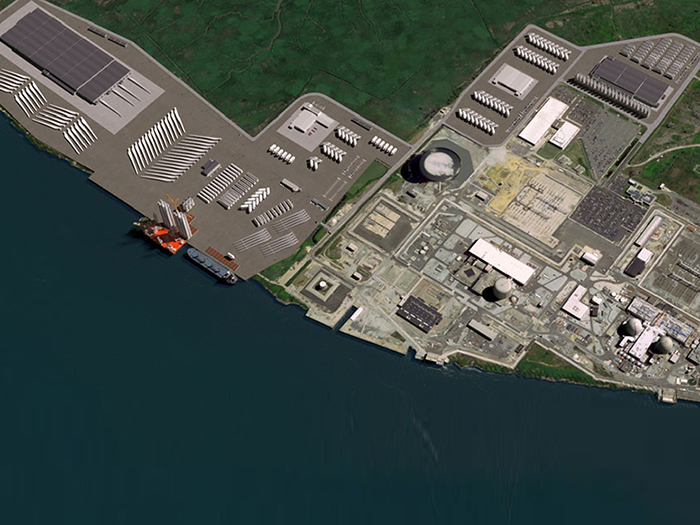
VIDEO: Governor Murphy unveils plans for New Jersey Wind Port
Written by Nick Blenkey
New Jersey Wind Port
New Jersey Governor Phil Murphy today announced plans to develop the New Jersey Wind Port, a first-in-the-nation infrastructure investment that will provide a location for essential staging, assembly, and manufacturing activities related to offshore wind projects on the East Coast.
The New Jersey Wind Port will be located in Lower Alloways Creek Township, on an artificial island on the eastern shores of the Delaware River, southwest of the City of Salem. The site was selected after a 22-month assessment process, including engagement with industry, government, and environmental stakeholders. The site is more than five miles from the nearest New Jersey residential area, can be built to meet the offshore wind industry’s needs, and has ample space to grow operations over time.
According to a statement from the governor’s office, the Wind Port has the potential to create up to 1,500 manufacturing, assembly, and operations jobs, as well as hundreds of construction jobs in New Jersey. Manufacturing and marshaling projects supported by the Wind Port will drive economic growth in Salem County, in South Jersey, and throughout the state. The state is committed to using union labor to construct the Wind Port and intends to set a new standard for inclusion of minority and women workers and business owners. Construction is targeted to begin in 2021.
“Offshore wind is a once-in-a-generation opportunity to not only protect our environment but also greatly expand our state economy in a way that has immediate impacts and paves the way for long-term growth,” said Governor Murphy. “The New Jersey Wind Port will create thousands of high-quality jobs, bring millions of investment dollars to our state, and establish New Jersey as the national capital of offshore wind. This is a vital step forward in achieving our goal of reaching 7,500 megawatts of offshore wind power by 2035 and 100 percent clean energy by 2050.”
Construction is planned in two phases, beginning in 2021. Phase 1 will develop a 30-acre site to accommodate marshaling activities and a 25-acre component manufacturing site. Phase 2 adds another 150+ acres to accommodate expanded marshalling activities and extensive manufacturing facilities for turbine components like blades and nacelles. The State currently estimates the Wind Port will cost between $300-400 million at full build. The New Jersey Economic Development Authority (NJEDA) is leading development and is currently considering a range of public, private, and public-private partnership (P3) financing options.
Offshore wind is a central component of the State’s plan to achieve 100 percent clean energy by 2050. As part of that plan, New Jersey has committed to producing 7,500 megawatts of offshore wind energy by 2035. Studies by the New Jersey Board of Public Utilities (NJBPU), U.S. Department of Energy, and offshore wind project developers have highlighted the need for new port facilities designed specifically to meet the offshore wind industry’s unique needs.
For example, wind turbines must be partially assembled at a port and then shipped out to the ocean vertically, with components as tall as 500 feet. When fully constructed on the ocean, the turbines selected for New Jersey’s first offshore wind project will be more than 850 feet tall. Given the height of the turbines, offshore wind marshaling ports must be located outside of all vertical restrictions, such as bridges, and must have wharfs that can accommodate up to 800 tons, or more than two fully loaded Boeing 777s. Most existing port infrastructure along the East Coast is unable to accommodate this work.
The offshore wind projects slated for development along the East Coast over the next decade are expected to require more than $100 billion of capital investment, creating an opportunity for significant economic growth. New Jersey’s location at the heart of the East Coast wind belt, commitment to supporting offshore wind, and diverse and highly skilled workforce put the state in a strong position to capitalize on this opportunity.
The NJEDA is leading development on behalf of the state and is working closely with the landowner, PSEG (Public Service Enterprise Group). The site is next to PSEG’s Hope Creek Nuclear Generation Station, and the company has partnered with the NJEDA to complete preparatory work to accelerate the project’s construction.
“By providing a location that can accommodate the industry’s manufacturing and marshaling needs, the New Jersey Wind Port will make New Jersey an international leader in offshore wind and a hub of the East Coast wind industry,” said Liz Burdock, President and CEO of the Business Network for Offshore Wind. “This is a concrete step toward an offshore wind supply chain born in the U.S.A.”




